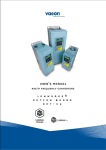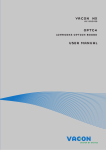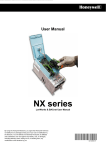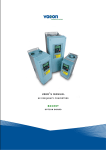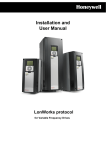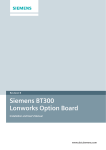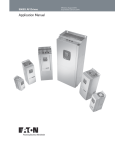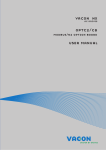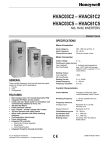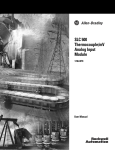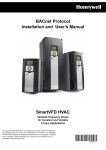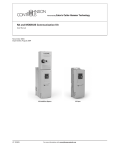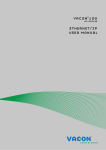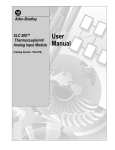Download User Manual - CONTROL SOLUTIONS & DESIGN, INC.
Transcript
Honeywell indexa 1(57) Honeywell User Manual NX series LonWorks & BACnet User Manual 62-0303-01 2 Index Honeywell INDEX 1. General .........................................................................................................................5 2. LonWorks C4 Option Board Technical Data .............................................................6 2.1 General ...................................................................................................................6 2.2 Physical Media and Wiring......................................................................................6 2.3 Profiles ....................................................................................................................7 2.3.1 Variable Speed Drive Profile.............................................................................8 3. LonWorks Fieldbus C4 Option Board Layout and Connections .............................9 3.1 LonWorks Opt-C4 Option Board .............................................................................9 3.2 Grounding Of Bus Cable Shield In Opt-C4..............................................................9 3.2.1 Grounding the bus cable shield directly to the frequency converter frame using the RC-filter .......................................................................................................10 3.3 Bus Termination Resistor......................................................................................12 3.4 Led Indications......................................................................................................12 4. Installation of Honeywell NX LonWorks C4 Option Board.....................................14 4.1 C4 Option Board Information Sticker.....................................................................16 5. Commissioning .........................................................................................................17 5.1 Fieldbus C4 Option Board Parameters .................................................................17 5.2 Start-Up Test.........................................................................................................17 6. LonWorks Interface...................................................................................................18 6.1 General .................................................................................................................18 6.2 Input Network Variables ........................................................................................20 6.3 Output Network Variables .....................................................................................23 6.4 Network Configuration Variables...........................................................................26 6.5 Process Data ........................................................................................................28 7. Fault Tracking............................................................................................................29 8. Appendix 1 .................................................................................................................30 9. General Info ...............................................................................................................32 10. BACnet CJ Option Board Technical data ................................................................33 10.1 System Software versions.....................................................................................34 11. Bacnet Fieldbus CJ Option Board Layout and Connections.................................35 12. Grounding Cable Shield............................................................................................36 12.1 Grounding by clamping the cable to the converter frame (recommended)............36 12.2 Grounding only one point on the net .....................................................................38 12.3 Bus Terminal Resistors .........................................................................................39 12.4 Bus Biasing ...........................................................................................................39 13. Led Indications ..........................................................................................................41 14. Installation of Honeywell NX BACnet CJ Option Board .........................................42 15. Commissioning .........................................................................................................44 15.1 Fieldbus CJ Option Board Parameters..................................................................44 15.2 Expander CJ Option Board Menu (M7) .................................................................44 15.3 BACnet Parameters ..............................................................................................44 15.3.1 Ms/Tp Mac Address (P7.X.1.1).......................................................................45 15.3.2 Baud Rate (P7.X.1.2)......................................................................................45 Honeywell Index 3 15.3.3 Instance Number (P7.X.1.3) ...........................................................................45 15.3.4 Communication Time-Out...............................................................................45 15.3.5 Communication Status (V7.X.2.1)...................................................................46 15.3.6 Baud Rate (V7.x.2.2) ......................................................................................46 15.3.7 Fault (V7.x.2.3) ..............................................................................................46 15.3.8 Index Nr. (V7.x.2.4)........................................................................................46 15.4 Annex - Protocol Implementation Conformance Statement (Normative)..............46 15.5 Object Map............................................................................................................49 15.5.1 Binary Value Object ........................................................................................50 15.5.2 Analog Value Object .......................................................................................52 16. Fault Tracking............................................................................................................55 Honeywell 4 Fieldbus LonWorks Bacnet Honeywell code NXOPTC4 NXOPTCJ Typecodes of the products Honeywell North America code 32006630-001 32006630-013 Manufacturer's code OPT-C4 OPT-CJ Honeywell product information and product manuals can be downloaded from following sites depending on geographical area: Honeywell EMEA (Europe, Middle East and Africa) products: http://ecc.emea.honeywell.com/products The inverter products can be found from ‘Building control products’ section in category ‘Frequency inverters’. Honeywell North America products: http://Customer.honeywell.com/vfd The VFD product manuals can be found from ‘Marketing & Technical Materials’ section in category ‘Product literature’. Honeywell 1. LonWorks General 5 General Honeywell NX frequency converters can be connected to the LonWorks® network using a fieldbus C4 option board. The converter can then be controlled, monitored and programmed from the Host system. The LonWorks® C4 option board shall be installed in slot E on the control C4 option board of the frequency converter. LonWorks technology has been developed by Echelon Corporation. LonWorks network is used in applications like industry and building automation, controlling household electronics, medical instrumentation and many others. The target of the LonWorks network is to provide a common vendor independent communication network for intelligent devices. In a LonWorks network, no central control or master-slave architecture is needed. Nodes on a network communicate with each other using LonTalk® protocol. Interoperable nodes use Standard Network Variable Types (SNVT) for communicating over the network. The definition of an SNVT includes units, a range, and an increment. Honeywell C4 option board uses only Standard Network Variable Types for the data types. All network variables are either input (data is coming from the network to the device) or output (data is sent to the network by the device) network variables. When network variables on different nodes on the network have been bound together by an installation tool, passing of data is automatic between the right nodes. Only the same type of network variables can be bound together, so it is very important to have compatible interfaces. WARNING! Internal components and circuit boards are at high potential when the frequency converter is connected to the power source. This voltage is extremely dangerous and may cause death or severe injury if you come into contact with it. 6 2. Honeywell LonWorks Technical Data LonWorks C4 Option Board Technical Data 2.1 General LonWorks connections Communications Environment Interface Pluggable connector (5 mm) Channel type Transfer cable Baud rate Ambient operating temperature Storing temperature Humidity Altitude Vibration TP/FT-10 Twisted pair 78 Kbit/s –10°C…50°C Safety –40°C…70°C <95%, no condensation allowed Max. 1000 m 0.5 G at 9…200 Hz Fulfils EN50178 standard Table 1. LonWorks technical data 2.2 Physical Media and Wiring LONWORKS networks can be implemented on many different physical media. Honeywell OPT-C4 option board is equipped with an FT-X1 transceiver supporting the Free Topology transformer coupled network, which allows the network wire to be connected as bus, star, loop or combination of these. This media reaches a communication speed of 78kBits/s. The FT-X1 transceiver is compatible with Echelon’s LPT-10 Link Power Transceiver, and these transceivers can communicate with each other on a single twisted pair cable. termination Figure 1. Doubly Terminated Bus Topology termination Figure 2. Singly Terminated Bus Topology termination Honeywell LonWorks Technical Data 7 termination Figure 3. Star Topology termination Figure 4. Loop Topology Up to 64 FTT-10 transceiver nodes are allowed per network segment, the individual segments can be connected together by a router. See Table 3 for recommended cable types and cable lengths for FTT-10. Even if unshielded cable types are recommended to be used with this type of transceiver, it is still highly recommended to use only shielded cables with frequency converters. Attention should be paid to proper grounding of the shield to ensure bus operation. Grounding of the shield should be done at both ends of the cable. Cable type Max. doubly terminated bus length 2700 m 2700 m Max. free topology wire length 500 m 500 m Belden 85102 (unshielded) Belden 8471 LONAK 2x1,3 (unshielded) Level IV, 22AWG 1400 m 500 m LONAK 2x2x0,65 (unshielded) JY (St) Y 2x2x0.8mm 900 m 500 m LONAK 2x2x0,8 (shielded) Table 2. Line length for different transmission speeds Max. node-tonode distance 500 m 400 m 400 m 320 m 2.3 Profiles LonMark Functional Profiles describe in detail the application layer interface, including the network variables, configuration properties, and default and power-up behaviors required on LonMark devices for specific, commonly used control functions. 8 2.3.1 LonWorks Technical Data Honeywell Variable Speed Drive Profile Leading manufacturers of drive technology have jointly defined the LonMark profile. The profile specifies how the drives are to be parameterized and how the setpoints and actual values are to be transmitted. This enables drives from different vendors to be exchanged. The profile contains necessary specifications for speed control and positioning. It specifies the basic drive functions while leaving sufficient freedom for application-specific expansions and further developments. Honeywell 3. LonWorks Layout and Connections 9 LonWorks Fieldbus C4 Option Board Layout and Connections Honeywell LonWorks Fieldbus C4 Option Board is connected to the fieldbus through 3-pin pluggable bus connector. The communication with the control C4 Option board takes place through the standard Honeywell Interface C4 Option Board Connector. 3.1 LonWorks Opt-C4 Option Board H3 H2 H1 X5 21 22 23 lw1.fh8 Figure 5. Honeywell I/O Boards C4 option board OPT Signal Connector A1 21 A2 22 0Shield 23 Table 3. OPT-C4 bus connector signals Description Data Data Shield 3.2 Grounding Of Bus Cable Shield In Opt-C4 The bus cable shield can be grounded to the frame of the frequency converter through an RC filter located on the OPT-C4 option board. Note: Normally, the C4 option board has already been installed in slot E of the control C4 Option board. It is not necessary to detach the whole C4 Option board for the grounding of the bus cable shield. Just detach the terminal block. 10 LonWorks Layout and Connections 3.2.1 Honeywell Grounding the bus cable shield directly to the frequency converter frame using the RC-filter 1 Strip about 5 cm of the cable as shown in the picture. Figure 6. 2 Leave no more than 7 mm of the data cable outside the terminal block (Figure 7) and strip the data cables at about 5 mm to fit in the terminals (Figure 8). Figure 7. Continues on next page Honeywell LonWorks Layout and Connections Figure 8. 3 Insert the data cables and the shield in their respective terminals. See Table 3. Figure 9. 4 If the LonWorks C4 option board was detached from the control unit place it into slot E of the control C4 option board (see C4 option board installation on page 14). Otherwise attach the terminal block. Fix the cable on the frame with the clamp. Figure 10. 11 12 Honeywell LonWorks Layout and Connections 3.3 Bus Termination Resistor To assure a proper data transmission, termination of the network segments is required. Depending on the type of network, either one or two terminations are necessary. Free topology network segment requires only one termination whereas a doubly terminated bus topology requires two. The jumper X5 on the Honeywell LonWorks C4 option board must be set accordingly. Use 94-ohm termination resistance when only one termination is needed and 47-ohm for two terminations. H3 H2 H1 47Ω 94Ω no termination X5 X5 21 22 23 lw1.fh8 Figure 11. Using jumper X5 to set the bus termination 3.4 Led Indications The three LED indications next to the connector show the present statuses of the Neuron (green H3), the LonWorks C4 option board (yellow H2) and the Fieldbus Module (green H1). From the user's viewpoint, the first two are the most significant. H3 H2 H1 X5 21 22 23 lw1.fh8 Figure 12. LED indications on the LonWorks C4 option board H3 H2 H1 Neuron Service LED C4 Option Board Status Bus Status GREEN YELLOW GREEN Honeywell LonWorks Layout and Connections Neuron status (H3) GREEN LED is: Meaning: OFF Configured ON Applicationless and Unconfigured Flashing Unconfigured 13 State Code 4 3 2 C4 Option Board status LED (H2) YELLOW LED is: Meaning: OFF C4 Option board not activated ON C4 Option board in initialisation state waiting for activation command from the frequency converter Blinking fast C4 Option board is activated and in RUN state (once/1 s) C4 Option board is ready for external communication Blinking slow C4 Option board is activated and in FAULT state (once/5 s) Internal fault on C4 option board Bus status LED (H1) GREEN LED is: Meaning: OFF Fieldbus module is waiting for parameters from the frequency converter No external communication ON Fieldbus module is activated Parameters received and module activated Module is waiting for messages from the bus Blinking very Fieldbus module has received a wink request. fast for 5s (once/0.2 s) Blinking fast Module is activated and receiving messages from the bus (once/1 s) Blinking slow Module is in FAULT state (once/5 s) No messages from Net within the watchdog time Bus broken, cable loose 14 4. Installation of Lonworks Board Honeywell Installation of Honeywell NX LonWorks C4 Option Board ! NOTE MAKE SURE THAT THE FREQUENCY CONVERTER IS SWITCHED OFF BEFORE AN OPTION OR FIELDBUS C4 OPTION BOARD IS CHANGED OR ADDED! A Honeywell NX frequency converter B Remove the cable cover. C Open the cover of the control unit. Continues on next page Honeywell D Installation of Lonworks Board Install LonWorks C4 option board in slot E on the control C4 option board of the frequency converter. Make sure that the grounding plate (see below) fits tightly in the clamp. H3 H2 H1 X5 21 22 23 lw1.fh8 E Make a sufficiently wide opening for your cable by cutting the grid as wide as necessary. F Close the cover of the control unit and the cable cover. 15 16 Installation of Lonworks Board Honeywell 4.1 C4 Option Board Information Sticker The LonWorks C4 option board package delivered by the factory includes a sticker (shown below). Please mark the C4 option board type (1), the slot into which the C4 option board is mounted (2) and the mounting date (3) on the sticker. Finally, attach the sticker on your drive. 1 3 Drive m odified: Option board: N XOPT................ Date:................... in slot: A B C D E IP54 upgrade/ Collar Date:................... EMC level modified: H T / T H Date:................... 2 Honeywell 5. LonWorks Commissioning 17 Commissioning READ FIRST CHAPTER 8 ‘COMMISSIONING’ in the User manual of the drive type used (see page 4 for download instructions for manuals). 5.1 Fieldbus C4 Option Board Parameters The Honeywell LonWorks C4 option board is commissioned with the control keypad by giving values to appropriate parameters in menu M7 (for locating the expander C4 option board menu, see NX User's Manual, Chapter 7). Expander C4 Option Board menu (M7) The Expander C4 option board menu makes it possible for the user 1) to see what expander C4 option boards are connected to the control C4 option board and 2) to reach and edit the parameters associated with the expander C4 option board. Enter the following menu level (G#) with the Menu button right. At this level, you can browse through slots A to E with the Browser buttons to see what expander C4 option boards are connected. On the lowermost line of the display you also see the number of parameter groups associated with the C4 option board. If you still press the Menu button right once you will reach the parameter group level including one parameter (Service pin). LonWorks parameters To commission the LonWorks C4 Option board, enter the parameter G7.5.1.1 from the Parameters group (G7.5.1). Give the desired value to the LonWorks parameter. # 1 Name Service Pin Default 0 Range 0..1 Description Broadcasts a service pin message to the network. Table 4. LonWorks parameters 5.2 Start-Up Test Frequency converter application Choose Fieldbus (Bus/Comm) for the active control place (see NX User's Manual, Chapter 7.3.3). Master software 1. Write 100.0 1 to nviDrvSpeedStpt. 2. Frequency converter status is RUN and output frequency is 1.00 * nviDrvSpeedScale 3. Write 0.0 0 to nviDrvSpeedStpt 4. Frequency converter status is STOP. If nvoDrvStats bit 3 = 1 Status of frequency converter is FAULT. 18 6. Honeywell LonWorks Interface LonWorks Interface Features of the LonWorks interface: • Direct control of Honeywell NX (e.g. Run, Stop, Direction, Speed reference, Fault reset) • Full access to all Honeywell NX parameters • Monitor Honeywell NX status (e.g. Output frequency, Output current, Fault code) 6.1 General Node Object:0 nv1 nviRequest SNVT_obj_request Mandatory Network Variables Figure 13. The Node object diagram nv2 nvoStatus SNVT_obj_status Honeywell LonWorks Interface nv1 nv2 nviDrvSpeedStpt SNVT_switch nviDrvSpeedScale SNVT_lev_percent 19 Variable Speed Motor Drive: 6010 Mandatory nvoDrvSpeed nv4 Network SNVT_levPercent Variables Optional Network Variables nv3 nvoDrvCurnt SNVT_amp nv6 nvoDrvPwr SNVT_power_kilo nv7 nvoDrvRunHours SNVT_time_hour nv27 nvoDrvStatus SNVT_state nv28 nvoDrvEnrgy SNVT_elect_kWh nv29 nvoActFault SNVT_count Configuration Properties nc50 nc53 nc48 nc49 nc52 nc158 nc159 nc160 nc161 nc162 nciMaxSpeed nciMinSpeed nciRcvHrtBt nciSndHrtBt nciMinOutTm nciNmlSpeed nciNmlFreq nciRampUpTm nciRampDownTm nciDrvSpeedScale nv8 nviRstFault SNVT_switch nv9 nviClrCntr SNVT_switch nv10 nviProcessIN1 SNVT_lev_percent nv11 nviProcessIN2 SNVT_lev_percent nv30 nvoProcessOut1 SNVT_lev_percent nv12 nviProcessIN3 SNVT_lev_percent nv31 nvoProcessOut2 SNVT_lev_percent nv13 nviProcessIN4 SNVT_lev_percent nv32 nvoProcessOut3 SNVT_lev_percent nv14 nviProcessIN5 SNVT_lev_percent nv33 nvoProcessOut4 SNVT_lev_percent nv15 nviProcessIN6 SNVT_lev_percent nv34 nvoProcessOut5 SNVT_lev_percent nv16 nviProcessIN7 SNVT_lev_percent nv35 nvoProcessOut6 SNVT_lev_percent nv17 nviProcessIN8 SNVT_lev_percent nv36 nvoProcessOut7 SNVT_lev_percent nv18 nviDigitalIn1 SNVT_switch nv37 nvoProcessOut8 SNVT_lev_percent nv19 nviDigitalIn2 SNVT_switch nv38 nvoDigitalOut1 SNVT_switch nv20 nviDigitalIn3 SNVT_switch nv39 nvoDigitalOut2 SNVT_switch nv21 nviDigitalIn4 SNVT_switch nv40 nvoDigitalOut3 SNVT_switch nv22 nviDigitalIn5 SNVT_switch nv41 nvoDigitalOut4 SNVT_switch nv23 nviDigitalIn6 SNVT_switch nv42 nvoDigitalOut5 SNVT_switch nv24 nviDigitalIn7 SNVT_switch nv43 nvoDigitalOut6 SNVT_switch nv25 nviDigitalIn8 SNVT_switch nv44 nvoDigitalOut7 SNVT_switch nv26 nviParCmd SNVT_preset nv45 nvoDigitalOut8 SNVT_switch nv46 nvoParResp SNVT_preset Manufacturer Defined Network Variables Figure 14. The Variable Speed Motor Drive object diagram 20 Honeywell LonWorks Interface 6.2 Input Network Variables Function Variable Name Node Object request nviRequest Driver speed nviDrvSpeedStpt setpoint Driver set point nviDrvSpeedScale speed scaling Reset fault nviRstFault Clear kWh trip or nviClrCntr Drive total running hours trip counters Process In Data nviProcessIn1..8 Digital Inputs nviDigitalIn1..8 Parameter Set nviParCmd Table 5. Network input variables SNVT type SNVT_obj_request SNVT_switch SNVT_lev_percent SNVT_switch SNVT_switch SNVT_lev_percent SNVT_switch SNVT_preset Min. Value Max. Value n/a n/a 163.84 0% n/a 1 163.830% 0 0 n/a 65535 4 n/a n/a 2 nviRequest This input network variable provides the mechanism to request a particular mode for the Node object or the Variable Speed Motor Drive object within a node. Supported requests are RQ_NORMAL, RQ_UPDATE_STATUS, RQ_CLEAR_STATUS, RQ_REPORT_MASK, RQ_DISABLED, RQ_ENABLE and RQ_CLEAR_ALARM. nviDrvSpeedStpt This input network variable provides control and a low resolution speed setpoint state 0 1 1 1 0xFF value NA 0 1 to 200 201 to 255 NA command Stop 0% 0.5 to 100% 100.0% Auto Table 6. nviDrvSpeedScale This input netork variable provides scaling for nviDrvSpeedStpt. Negative values indicate a motor direction in reverse. For example, if the nviDrvSpeedStpt value is 50% and nviDrvSpeedScale -150%, then the actual speed setpoint is –75%, or 0.75 times the nominal speed in reverse direction. The valid range is –163,840% to 163,830. The value 0x7FFF (+163,835%) will be handled as an invalid value. Default value is determined by nciDrvSpeedScale. This value will be adopted at power-up and in case of not receiving an update within the specified Receive Heartbeat time. Honeywell LonWorks Interface 21 nviRstFault This input network variable provides a fault reset. Setting value 1 for State and a non-zero value for Value will reset an active fault in Honeywell NX. Default value is 0; 0. State 0 1 1 -1 (0xFF) Value any 0 >0 any Command no action (0; 0) no action (0; 1) reset fault (200 ; 0) invalid (no action) Table 7. nviClrCntr This input network variable provides a mechanism to clear the kWh trip counter or the Drive total running hours trip counter. 1 MWh trip counter 2 Operation day trip counter nviProcessIn1..8 These input network variables are sent directly to the application (see more detailed explanation in chapter 6.5 Process Data) The valid range is 0 to 65535 (-163,840 to 163,835). nviDigitalIn1..8 These input network variables are sent directly to the application (see more detailed explanation in chapter 6.5 Process Data) Default value is 0; 0. state 0 1 1 -1 (0xFF) value any 0 >0 any command off (0; 0) off (0; 1) on (200; 1) invalid (no action) Table 8. nviParCmd This input network variable is used to read and write the parameters. The parameter addresses are determined in the application. Every parameter and actual value has been given an ID number in the application. The ID numbering of the parameter as well as the parameter ranges and steps can be found in the application manual in question. The parameter value must be given without decimals. Find the ID numbers of each parameter/actual value in the application manual. The ID numbers are grouped as follows: 22 Honeywell LonWorks Interface Parameter ID Group 0 Not used 1 … 98 Actual Values 99 Active Fault Code 100 Not Used 101… 899 Parameter 900 … 999 Reserved Description Reserved for LonWorks C4 option board internal usage 1000 Not Used 1001…1999 Parameter Table 9. Grouping of ID numbers Examples Data format in examples is: - learn selector <byte(3) byte(2) byte(1) byte(0)> day hour minute second millisecond x = meaningless. Example1 Write to parameter number 102 (Max frequency “Basic Application par. ID102”) value 4500 (45Hz). Write command to nviParSet - LN_LEARN_CURRENT 102 <x x 11 94> x x x x If the write command is successful then nvoParOut value is - LN_LEARN_CURRENT 102 <0 0 11 94> 0 0 0 0 If the write command fails then nvoParOut value is - LN_NUL 102 <0 0 11 94> 0 0 0 0 Honeywell LonWorks Interface 23 Example2 Read parameter number 112 (Nominal speed of the motor “Basic Application par. ID112”) default value 1440 (1440 rpm). Read command to nviParSet - LN_RECALL 112 <x x x x> x x x x If the read command is successful then nvoParOut value is - LN_RECALL 112 <0 0 5 A0> 0 0 0 0 If the read command fails then nvoParOut value is - LN_ LN_NUL 112 <0 0 0 0> 0 0 0 0 6.3 Output Network Variables Function Variable Name SNVT type Min. Value Max. Value Node Object status Drive speed feedback Actual motor current Actual drive power Drive total running hours nvoStatus nvoDrvSpeed nvoDrvCurnt nvoDrvPwr nvoDrvRunHours nvoDrvStatus nvoDrvEnrgy nvoActFault nvoProcessOut1..8 nvoDigitalOut1..8 nvoParResp SNVT_obj_status SNVT_lev_percent SNVT_amp SNVT_power_kilo SNVT_time_hour SNVT_state SNVT_elect_kwh SNVT_count SNVT_ lev_percent SNVT_switch SNVT_preset -163.840% 0.0A 0,0 kW 0h n/a 0kWh 0 0 0 - +163.830% 3276.7A 6553,5 kW 65535 n/a 65535kWh 41 65535 4 - Status word kWh trip counter Active fault code Process Out Digital Out Parameter Out Table 10. Network output variables NvoStatus This output network variable reports the status for Node object or Variable Speed Motor Drive object. 24 LonWorks Interface Field Honeywell Description object_id ID of object within node invalid_id 1 means requested ID is not implemented in this node invalid_request 1 means request for unimplemented function disabled 1 means object disabled electrical_fault 1 means drive is faultefd in_alarm 1 means drive is in alarm report_mask 1 means status is an event mask Table 11. nvoDrvSpeed This output network variable provides the speed of the drive as a percentage of the nominal speed. nvoDrvCurnt This output network variable provides the drive output current in amperes. nvoDrvPwr This output network variable provides the drive output power in kW. nvoDrvRunHours This output network variable provides the drive resettable operation time counter for the motor in running hours. The maximum value for used SNVT is 65535 h. On the frequency converter the value can go much higher. If the counter exceeds the SNVT’s maximum value, the network variable stays at its maximum. In such cases the real value can be seen on Honeywell NX’s operating keypad. Honeywell LonWorks Interface 25 nvoDrvStatus This output network variable provides the drive status. Bit 0 1 2 3 4 5 Description Value = 0 Not Ready FC stopped Clockwise No fault No warning Reference ≠ Actual value Value = 1 Ready Running Counterclockwise Fault active Warning active Reference = Actual value Table 12. Status word bit descriptions nvoDrvEnrgy This output network variable provides the drive resettable energy consumption counter. The maximum value for used SNVT is 65535 kWh. On the frequency converter the value can go much higher. If the counter exceeds the SNVT’s maximum value, the network variable stays at its maximum. In such cases the real value can be seen on Honeywell NX’s operating keypad. nvoActFault This output network variable provides the drive active fault code. If the value is 0 the frequency converter has no fault. See the fault code list in NX Frequency Converter User’s Manual for fault identification. nvoProcessOut1..8 These output network variables are sent directly from the application (see more detailed explanation in chapter 6.5 Process Data) The valid range is 0 to 65535 (-163,840 to 163,835). nvoDigitalOut1..8 These output network variables are sent directly from the application (see more detailed explanation in chapter 6.5 Process Data). state 0 1 -1 (0XfF) value 0 200 (0xC8) any Table 13. nvoParResp explained in chapter nviParSet. command off (0; 0) on (200; 1) invalid (NULL) 26 LonWorks Interface Honeywell 6.4 Network Configuration Variables Function Maximum motor speed Minimum motor speed Receive heartbeat time Send heartbeat time Minimum output time Nominal motor speed in RPM Nominal motor frequency Minimum ramp up time Minimum ramp down time Default value for nviDrvSpeedScale Variable Name nciMaxSpeed nciMinSpeed nciRcvHrtBt nciSndHrtBt nciMinOutTime nciNmlSpeed nciNmlFreq nciRampUpTm nciRampDownTm nciDrvSpeedScale SNVT type SCPTmaxSetpoint SCPTminSetpoint SCPTmaxRcvTime SCPTmaxSndTime SCPTminSndTime SCPTnomRPM SCPTnomFreq SCPTrampUpTm SCPTrampDownTm SCPTdefScale Table 14. Network configuration variables nciMaxSpeed This configuration property is used to define the maximum speed of a motor. The value is entered as a percentage of nominal speed in RPM, as defined by the Nominal Speed (nciNmlSpeed) configuration value. The value of the maximum speed must be validated against the value of the minimum speed as follows: -163.840 < minimum speed < maximum speed < 163.830 nciMinSpeed This configuration property is used to define the minimum speed of the motor. The value is entered as a percentage of nominal speed in RPM, as defined by the Nominal Speed (nciNmlSpeed) configuration value. The value of the minimum speed must be validated against the value of the maximum speed as follows: -163.840 < minimum speed < maximum speed < 163.830 nciRcvHrtBt This configuration property is used to control the maximum time that elapses after the last update of the network variables nviDrvSpeedStpt or nviDrvSpeedScale before the VSD object starts to use the default values. nciSndHrtBt This configuration property defines the maximum period that expires before the network variables nvoDrvSpeed, nvoDrvCurnt and nvoDrvPwr are automatically updated. nciMinOutTime This configuration property defines the minimum period of automatic network variable tansmission. nciNmlSpeed This configuration property is used to provide the nominal speed of the motor in RPM. This value is necessary to determine the minimum and maximum speeds for the motor, based on the configuration properties nciMinSpeed, nciMaxSpeed (entered as a percentage of nominal speed). Honeywell LonWorks Interface 27 nciNmlFreq This configuration property is used to provide the nominal frequency for the motor. nciRampUpTm Defines the acceleration time for Honeywell NX. The valid range is 0.0 to 6,553.4 sec (0.1 sec). nciRampDownTm Defines the deceleration time for Honeywell NX. The valid range is 0.0 to 6,553.4 sec (0.1 sec). nciDrvSpeedScale This configuration property is used as the default value for nviDrvSpeedScale. This value will be adopted at power-up and in case no input variable within the specified Receive Heartbeat time is received. 28 Honeywell LonWorks Interface 6.5 Process Data Aplication FBProcessDataIn1..8 LonWorks nviProcessIn1..8 nviDigitaln 1 bit 3 nviDigitaln 2 bit 4 nviDigitaln 3 bit 5 nviDigitaln 4 bit 6 nviDigitaln 5 bit 7 nviDigitaln 6 bit 10 nviDigitaln 7 bit 11 nviDigitaln 8 bit 12 nvoProcessOut1..8 FBFixedControlWord FBProcessDataOut1..8 nvoDigitaOut 1 bit 0 nvoDigitaOut 2 bit 1 nvoDigitaOut 3 bit 2 nvoDigitaOut 4 bit 3 nvoDigitaOut 5 bit 4 nvoDigitaOut 6 bit 5 nvoDigitaOut 7 bit 6 nvoDigitaOut 8 bit 7 Figure 15. Control of frequency converter through LonWorks FBGeneralStatusWord Honeywell 7. LonWorks Fault Tracking 29 Fault Tracking The table below presents the faults related to the LonWorks C4 option board. For more information, see also NX User's Manual, Chapter 9. The LonWorks C4 option board status LEDs are described in more detail in Chapter 3.4. Fault code 37 38 39 Fault Possible cause Correcting measures 53 Device change Device added Device removed Device unknown Fieldbus fault The received heartbeat time has expired. Check the installation. If installation is correct contact the nearest Honeywell distributor. 54 Slot fault Defective C4 option board or slot Check the C4 option board and slot. Contact the nearest Honeywell distributor. 40 C4 Option board changed. C4 Option board added. C4Option board removed. Reset Reset Reset Unknown option board. Table 15. LonWorks C4 option board faults You can define with parameters how the frequency converter shall react to certain faults: Code Parameter Min Max P2.7.22 Response to fieldbus fault 0 P2.7.23 Response to slot fault 0 Unit Step Default ID 3 1 0 733 3 1 0 734 Table 16. Frequency converter responses to faults Note 0=No response 1=Warning 2=Fault,stop acc. to 2.4.7 3=Fault,stop by coasting 0=No response 1=Warning 2=Fault,stop acc. to 2.4.7 3=Fault,stop by coasting 30 8. Honeywell LonWorks Appendix Appendix 1 Process Data OUT The nodes can read the frequency converter’s actual values using process data variables. Basic, Standard, Local/Remote, Multi-Step, PID control and Pump and fan control applications use process data as follows: Data Process data OUT 1 Process data OUT 2 Process data OUT 3 Process data OUT 4 Process data OUT 5 Process data OUT 6 Process data OUT 7 Process data OUT 8 Value Output Frequency Motor Speed Motor Current Motor Torque Motor Power Motor Voltage DC link voltage Active Fault Code Unit Hz rpm A % % V V - Scale 0,01 Hz 1 rpm 0,1 A 0,1 % 0,1 % 0,1 V 1V - The Multipurpose Control Application has a selector parameter for every Process Data. The monitoring values and drive parameters can be selected using the ID number (see NX All in One Application Manual, Tables for monitoring values and parameters). Default selections are as in the table above. Process Data IN Process Data is used with All-inOne applications as follows: Basic, Standard, Local/Remote, Multi-Step applications Data PD1 – PD8 Value Not used Unit - Step - Unit % % Step 0.1% 0.01% % - 0.01% - Multipurpose control application Data Process Data IN1 Process Data IN2 Process Data IN3 PD3 – PD8 Value Torque Reference Free Analogue INPUT Adjust Input Not Used Honeywell LonWorks Appendix 31 PID control and Pump and fan control applications Data Process Data IN1 Process Data IN2 Process Data IN3 PD4–PD8 Value Unit Reference for PID % controller Actual Value 1 to PID % controller Actual Value 2 to PID % controller Not Used - Step 0.01% 0.01% 0.01% - 32 9. BACnet General Honeywell General Info Instead of sending and receiving information to and from frequency converters through I/O, you can connect them to a fieldbus. Honeywell NX frequency converters can be connected to the RS-485 bus using a fieldbus CJ option board. The converter can then be controlled, monitored and programmed from the host system. BACnet is also known by names Direct Digital Control Systems and Building Management Systems. BACnet technology is used mostly in building automation, lightning control, air conditioning and in heating automation. The protocol is an upper level net protocol suitable for large building automation projects. BACnet stands for Building Automation and Control Network. BACnet is a true nonpropriatery open protocol communication standard conceived by a consortium of building management, system users and manufacturers. If you purchase your BACnet CJ option board separately, please note that it shall be installed in slot E on the control CJ option board of the frequency converter. WARNING! Internal components and circuit boards are at high potential when the frequency converter is connected to the power source. This voltage is extremely dangerous and may cause death or severe injury if you come into contact with it. Honeywell 10. BACnet Technical Data 33 BACnet CJ Option Board Technical data Connections Communications Interface Data transfer method Transfer cable Electrical isolation BACnet MS/TP Baud rate Environment MAC Addresses Ambient operating temperature Storing temperature Humidity Altitude Vibration Safety Table 17. BACnet technical data OPT-CJ: Pluggable connector (5.08mm) RS-485 MS/TP, half-duplex Twisted pair (1 pair and shield) 500 VDC As described in ANSI/ASHRAE Standards 1352004 9600, 19200, 38400 and 76800 baud (supports autobaud detection) 1 to 127 –10°C…55°C –40°C…60°C <95%, no condensation allowed Max. 1000 m 0.5 G at 9…200 Hz Fulfils EN50178 standard 34 BACnet Technical Data Honeywell 10.1 System Software versions OPT-CJ BACnet option board is supported from system software versions: • • • NXL NXL00005V149.VCN NXS NXS00001V161.VCN NXP NXP00002V160.VCN Autobaud detection and BACnet specific fault codes (readable from panel) are added from system software versions: • • • NXL NXL00005V248.VCN NXS NXS00001V163.VCN NXP NXP00002V162.VCN Communication timeout is available from system SW versions. When not supported, the default is 10 seconds. • • • NXL NXL00005V254.VCN NXS NXS00001V167.VCN NXP NXP00002V168.VCN OPT-CJ software version OPTCJ_10522V009 and newer: New baud rate 76800 from software versions: • • • NXL: NXL00005V257.VCN NXS: NXS00001V170.VCN NXP: NXP00002V171.VCN Honeywell 11. BACnet Layout and Connections 35 Bacnet Fieldbus CJ Option Board Layout and Connections Honeywell BACnet CJ option board is connected to the fieldbus through a 5-pin pluggable bus connector. The communication with the control board of the frequency converter takes place through the standard Honeywell Interface CJ Option Board Connector. 1 2 3 4 5 X4 X1 Bus connector Jumpers Grounding plate Interface board connector Figure 16. Honeywell BACnet CJ option board OPT Signal NC* VP RxD/TxD –N RxD/TxD –P DGND Connector 1* 2 3 4 5 Description No connection Supply voltage – plus (5V) Receive/Transmit data – A Receive/Transmit data – B Data ground (reference potential for VP) *You can use this pin (1) to bypass the cable shield to the next slave Table 18. OPT-CJ bus connector signals 36 12. Honeywell BACnet Grounding Cable Shield Grounding Cable Shield 12.1 Grounding by clamping the cable to the converter frame (recommended) This manner of grounding is the most effective and especially recommended when the distances between the devices are relatively short or if the device is the last device on the net. Note: Normally, the CJ option board has already been installed in slot D or slot E of the control CJ option board. It is not necessary to detach the whole CJ option board for the grounding of the bus cable shield. Just detach the terminal block. 1 Strip about 5 cm of the cable and cut off the grey cable shield. Remember to do this for both bus cables (except for the last device). See pictures below. 2 Leave no more than 1 cm of the cable outside the terminal block and strip the data cables at about 0.5 cm to fit in the terminals. See pictures below. Note: Do this for both bus cables. Strip this part Cut here Figure 17. 1 2 3 4 5 A Figure 18. B Honeywell BACnet Grounding Cable Shield 37 3 Insert the data cables of both cables into terminals #3 (Line B) and #4 (Line A). 4 Strip the cable at such a distance from the terminal that you can fix it to the frame with the grounding clamp. See pictures below: Figure 19. 38 Honeywell BACnet Grounding Cable Shield 12.2 Grounding only one point on the net In this manner of grounding, the shield is connected to ground only at the last device on the net in the same way as described in chapter 12.1. Other devices of the net just pass the shield. We recommend you to use an Abico connector to fit the shields into the terminal. 1. Strip about 5 cm of the cable and cut off the grey cable shield. Remember to do this for both bus cables (except for the last device). 2. Leave no more than 1 cm of the cable outside the terminal block and strip the data cable at about 0.5 cm to fit in the terminals. See Figure 20. 1 2 3 4 5 Shield A Figure 20. Note! Do this for both cables. 3. Fix both the cables on the frame with the clamp. See Figure 21. Figure 21. B Honeywell BACnet Grounding Cable Shield 39 12.3 Bus Terminal Resistors Figure 22. Using jumper X4 to set the bus termination If Honeywell is the last device of the fieldbus line the bus termination must be set. Use jumper X4 (ON position). See Figure 22. Note: Jumper X1 is only used when D9 type connector is assembled (Not used with BACnet protocol) 12.4 Bus Biasing Bus biasing is required to ensure faultless communication between devices at RS-485 bus. Bus biasing makes sure that the bus state is at proper potential when no device is transmitting. Without biasing, faulty messages can be detected when the bus is in idle state. RS-485 bus state should be neather +0,200..+7V or –0,200..-7V. Illegal bus state is <200mV..-200mV. Number of nodes 2-5 5-10 11-20 21-30 31-40 Bias resistance 1.8 kohm 2.7 kohm 12 kohm 18 kohm 27 kohm Table 19. Bias resistor size vs number of node 40 BACnet Grounding Cable Shield Honeywell Fail safe biasing in OPT-CJ option board Connect resistor biasing resistors between pins #2 and #4 as well as pins #3 and #5 as shown in picture. 1 2 DATA A 3 DATA B 4 5 Matters related to this are discussed in the application note Failsafe Biasing of Differential Buses (an-847.pdf) published by National Semiconductor (www.national.com). 5 Honeywell 13. BACnet LED Indications 41 Led Indications The two LED indications next to the connector show the present statuses of the BACnet CJ option board (yellow) and the Fieldbus Module (green). Yellow Green 1 2 3 4 5 X4 X1 Figure 23. LED indications on the BACnet CJ option board BACnet CJ option board status LED (BS) YELLOW LED is: OFF ON Meaning: CJ Option board not activated CJ Option board in initialisation state waiting for activation command from the frequency converter Blinking fast CJ Option board is activated and in RUN state (once/sec) • CJ Option board is ready for external communication Blinking CJ Option board is activated and in FAULT state slow • Internal fault of CJ option board (once/5 secs) Fieldbus status LED (FS) GREEN LED is: OFF Meaning: Fieldbus module is waiting for parameters from the frequency converter • No external communication ON Fieldbus module is activated • Parameters received and module activated • Module is waiting for messages from the bus Blinking fast Module is activated and receiving messages from the (once/sec) bus Blinking Module is in FAULT state slow • No messages from Master within the watchdog (once/5 time secs) • Bus broken, cable loose or Master off line 42 Installation of BACnet Board 14. Installation of Honeywell NX BACnet CJ Option Board A Honeywell NX frequency converter. B Remove the cable cover. C Open the cover of the control unit. Honeywell Continues on next page Honeywell Installation of BACnet Board 43 D Install BACnet CJ option board in slot E on the control CJ option board of the frequency converter. Make sure that the grounding plate (see below) fits tightly in the clamp. E Make a sufficiently wide opening for your cable by cutting the grid as wide as necessary. F Close the cover of the control unit and the cable cover. 44 15. Honeywell BACnet Commissioning Commissioning READ FIRST CHAPTER 8 'COMMISSIONING' in the User manual of the drive type used (see page 4 for download instructions for manuals). Note! You must select Fieldbus as the active control place, if you wish to control the frequency converter through fieldbus. See NX User’s Manual, Chapter 7.3.3.1. 15.1 Fieldbus CJ Option Board Parameters The Honeywell BACnet CJ option board is commissioned with the control keypad by giving values to appropriate parameters in menu M7 (for locating the expander CJ option board menu see NX User's Manual, Chapter 7). 15.2 Expander CJ Option Board Menu (M7) The Expander CJ option board menu makes it possible for the user 1) to see what expander CJ option boards are connected to the control CJ option board and 2) to reach and edit the parameters associated with the expander CJ option board. Enter the following menu level (G#) with the Menu button right. At this level, you can browse through slots A to E with the Browser buttons to see what expander CJ option boards are connected. On the lowermost line of the display you also see the number of parameter groups associated with the CJ option board. If you still press the Menu button right once you will reach the parameter group level where there are two groups: Editable parameters and Monitored values. A further press on the Menu button right takes you to either of these groups. 15.3 BACnet Parameters To commission the RS-485 CJ option board, enter the level P7.5.1.# from the Parameters group (G7.5.1). Give desired values to all RS-485 parameters (see Figure 24 and Table 20). READY R E ADY Expander Board G1 G5 Slave address I/Oter m NXOPTCJ Parameters G1 G2 R E ADY I / Ot e r m 126 READ Y I / Ot er m I / Ot e r m P1 P4 READY I /Oter m CHANGE VALUE Slave address 126 enter CONFIRM CHANGE Figure 24. Changing the BACnet CJ option board commissioning parameter values Honeywell # 1 2 Name MAC ADDRESS BAUD RATE BACnet Commissioning Default 1 1 3 4 INDEX NR. Comm. time-out Range 1…127 0 - Auto 1 – 9600 baud 2 – 19200 baud 3 – 38400 baud 4 – 76800 baud Countin g number 0-65535 10 s 0 = OFF 10 – 60 s 45 Description Communication speed Instance Number. Zero means that unique default device object instance number is used. Communication time-out 0 = Not in use Table 20. BACnet CJ option board parameters 15.3.1 Ms/Tp Mac Address (P7.X.1.1) The parameters of every device must be set before connecting to the bus. Especially the parameters MAC Address and Baud Rate must be the same as in the master configuration. The first parameter, MAC (Medium Access Control) address, must be unique on the network to which it is connected. The same MAC address may be used on a device on another network within the internetwork. Addresses 128-254 are reserved for slaves. Addresses 1-127 are valid for both masters and slaves. The portion of the address space that is actually used for masters in a particular installation is determined by the value of the Max_Master property of the Device object. It is recommended that MAC address 0 be reserved for use by the MS/TP router and 255 is reserved for broadcasts. 15.3.2 Baud Rate (P7.X.1.2) Select the communication speed for the network. Default value is 9600 baud. 0 (– Auto) means that automatic baud rate detection is used. The used Baudrate is shown in monitor menu. 15.3.3 Instance Number (P7.X.1.3) The Device Object's Instance number must be unique across the entire BACnet internetwork because it is used to uniquely identify the BACnet devices. It may be used to conveniently identify the BACnet device from other devices during installation. If 0 (default) is selected, the Device Instance number is read from Drive. This unique number is then shown in Monitor menu. If any other value than zero is selected, the value is used as Device Object’s Instance number. The actual value is shown in monitor menu. 15.3.4 Communication Time-Out BACnet CJ option board initiates a communication error if the communication is broken for as long as defined by the parameter Communication time-out. Communication time-out is disabled when the parameter is given the value 0. The step for setting the time-out time is 10 seconds. 46 Honeywell BACnet Commissioning 15.3.5 Communication Status (V7.X.2.1) To see the present status of the RS-485 fieldbus, enter the Comm.Status page from Monitor menu (G7.5.2). See Figure 25 and Table 21 below. Figure 25. Communication status 0…999 0…64 Good messages Number of messages received without communication errors Bad Frames Number of messages received with CRC or parity errors Table 21. BACnet message indications 15.3.6 Baud Rate (V7.x.2.2) Shows the actual baud rate. 15.3.7 Fault (V7.x.2.3) Shows BACnet fault codes. See Table 24 from Chapter 16. 15.3.8 Index Nr. (V7.x.2.4) Shows the Device Object's Instance number. 15.4 Annex - Protocol Implementation Conformance Statement (Normative) (This annex is part of this Standard and is required for its use.) BACnet Protocol Implementation Conformance Statement Date: May 31, 2005 Vendor Name: Honeywell Product Name: Honeywell Drive – xxx (xxx = MAC ID) Product Model Number: OPTCJ Applications Software Version: 10522 Firmware Revision: Revision: 4 1 BACnet Protocol Honeywell BACnet Commissioning 47 Product Description: BACnet CJ Option board is designed for Honeywell NX family devices. BACnet Standardized Device Profile (Annex L): BACnet Application Specific Controller (B-ASC) List all BACnet Interoperability Building Blocks Supported (Annex K): DS-RP-B, DSWP-B, DM-DDB-B, DM-DOB-B. Segmentation Capability: Segmented requests supported Segmented responses supported Window Size Window Size Standard Object Types Supported: An object type is supported if it may be present in the device. For each standard Object Type supported provide the following data: 1) Whether objects of this type are dynamically creatable using the CreateObject service 2) Whether objects of this type are dynamically deletable using the DeleteObject service 3) List of the optional properties supported 4) List of all properties that are writable where not otherwise required by this standard 5) List of proprietary properties and for each its property identifier, datatype, and meaning 6) List of any property range restrictions Data Link Layer Options: MS/TP master (Clause 9), baud rate(s): 9600, 19200, 34800, 76800 (supports autobaud detection) Device Address Binding: Is static device binding supported? (This is currently necessary for two-way communication with MS/TP slaves and certain other devices.) Yes g No Networking Options: Router, Clause 6 - List all routing configurations, e.g., ARCNET-Ethernet, Ethernet-MS/TP, etc. Annex H, BACnet Tunneling Router over IP BACnet/IP Broadcast Management Device (BBMD) Does the BBMD support registrations by Foreign Devices? Yes No Character Sets Supported: Indicating support for multiple character sets does not imply that they can all be supported simultaneously. 48 BACnet Commissioning Honeywell ISO 8859-1 ANSI X3.4 IBM™/Microsoft™ DBCS ISO 10646 (UCS-2) ISO 10646 (UCS-4) JIS C 6226 If this product is a communication gateway, describe the types of non-BACnet equipment/networks(s) that the gateway supports. Honeywell BACnet Commissioning 15.5 Object Map Object types and properties supported Object Type Property Device Binary Analog Value Value Object Identifier X X X Object Name X X X Object Type X X X System Status X Vendor Name X Vendor Identifier X Model Name X Firmware Revision X Appl Software revision X Protocol Version X Protocol Revision X Services Supported X Object Types X supported Object List X Max APDU Length X Segmentation Support X APDU Timeout X Number ADPU Retries X Max Master X Max Info Frames X Device Address X Binding Database Revision X Preset Value X X Status Flags X X Event State X X Out-of-Service X X Units X ) Priority Array X* X*) ) Relinquish Default X* X*) Polarity Active Text X Inactive Text X Figure 26. Object types and properties supported * Only with commandable values 49 50 Honeywell BACnet Commissioning 15.5.1 Binary Value Object Instance ID Object Name BV0 Ready State BV1 Run/Stop State BV2 Fwd/Rev State BV3 Fault State BV4 Warning State BV5 At Setpoint BV6 At Zero Speed BV7 General 0 BV8 General 1 BV9 General 2 BV10 General 3 BV11 General 4 BV12 General 5 BV13 General 6 BV14 General 7 BV15 Run/Stop CMD BV16 Fwd/Rev CMD BV17 Reset Fault BV18 FBFixedControlWord Bit_3 BV19 FBFixedControlWord Bit_4 BV20 FBFixedControlWord Bit_5 BV21 FBFixedControlWord Bit_6 BV22 FBFixedControlWord Bit_7 Description Inactive / Active Indicates whether the drive is ready or not Indicates whether the drive is running or stopped Indicates the rotation direction of the motor Indicates if a fault is active Indicates if a warning is active Ref. Frequency reached Not Ready / Ready Present Value Access Type R Stop / Run R Fwd / Rev R OK / Fault R OK / Warning R False / True R Motor Running at zero speed Application specific bit from drives General Status Word Application specific bit from drives General Status Word Application specific bit from drives General Status Word Application specific bit from drives General Status Word Application specific bit from drives General Status Word Application specific bit from drives General Status Word Application specific bit from drives General Status Word Application specific bit from drives General Status Word Command to start drive (FB control is active) Command to change rotational direction (FB control is active) Command to reset Active Fault from dirve Application Specific bit From the Fixed Control Word Application Specific bit From the Fixed Control Word Application Specific bit From the Fixed Control Word Application Specific bit From the Fixed Control Word Application Specific bit From the Fixed Control Word False / True R 0/1 R 0/1 R 0/1 R 0/1 R 0/1 R 0/1 R 0/1 R 0/1 R Stop / Run C Fwd / Rev C 0 / Reset C 0/1 C 0/1 C 0/1 C 0/1 C 0/1 C Continues on next page Honeywell BACnet Commissioning BV23 FBFixedControlWord Bit_8 BV24 FBFixedControlWord Bit_9 BV25 FBFixedControlWord Bit_10 BV26 FBFixedControlWord Bit_11 BV27 FBFixedControlWord Bit_12 BV28 FBFixedControlWord Bit_13 BV29 FBFixedControlWord Bit_14 BV30 FBFixedControlWord Bit_15 Application Specific bit From the Fixed Control Word Application Specific bit From the Fixed Control Word Application Specific bit From the Fixed Control Word Application Specific bit From the Fixed Control Word Application Specific bit From the Fixed Control Word Application Specific bit From the Fixed Control Word Application Specific bit From the Fixed Control Word Application Specific bit From the Fixed Control Word 51 0/1 C 0/1 C 0/1 C 0/1 C 0/1 C 0/1 C 0/1 C 0/1 C NOTE: For Present Value Access Types, R = Read-only, W = Writeable, C = Commandable. Commandable values support priority arrays & relinquish defaults. 52 15.5.2 BACnet Commissioning Honeywell Analog Value Object Instance ID Object Name Description Units AV0 Frequency Setpoint Frequency Setpoint Hz AV1 Output Frequency Output Frequency Hz R AV2 Motor Speed Motor Speed Rpm R AV3 Load (power) Motor Shaft Power Percent R Kilowatt Hours total Megawatt Hour Counter (Total) kWh R AV5 Motor Current Motor Current Amps R AV6 DC link Voltage DC link Voltage Volts R AV7 Motor Voltage Motor Voltage Volts R Heatsink Temperature NOT IN NXL -series In % of motor nominal Torque Operating Days (resettable) Operating Hours (resettable) Kilowatt Hours (resettable) °C R Percent R Day R Hour R kWh R Percent R Percent R AV4 AV8 AV9 AV10 Unit Temperature Motor Torque Operating Days AV11 Operating Hours AV12 Kilowatt Hours AV13 Present Value Access Type R Torque Reference Torque Reference NOT IN NXL -series Temperature Rise Calculated motor temperature 100,0% = nominal temperature of motor NOT IN NXL -series FBProcessDataOut1 Application specific -32768.0 to +32767.0 resolution 1.0 R FBProcessDataOut2 Application specific -32768.0 to +32767.0 resolution 1.0 R FBProcessDataOut3 Application specific -32768.0 to +32767.0 resolution 1.0 R FBProcessDataOut4 Application specific -32768.0 to +32767.0 resolution 1.0 R FBProcessDataOut5 Application specific -32768.0 to +32767.0 resolution 1.0 R FBProcessDataOut6 Application specific -32768.0 to +32767.0 resolution 1.0 R FBProcessDataOut7 Application specific -32768.0 to +32767.0 resolution 1.0 R FBProcessDataOut8 Application specific -32768.0 to +32767.0 resolution 1.0 R Active Fault Code Active Fault Code - R Speed Reference, percentage of nominal speed Percent C Speed Reference AV25 Current Limit Current Limit Amps W AV26 Min Frequency Minimum Frequency Hz W AV14 AV15 AV16 AV17 AV18 AV19 AV20 AV21 AV22 AV23 AV24 Continues on next page Honeywell BACnet Commissioning 53 AV27 Maximum Frequency Maximum Frequency Hz W AV28 Accel Time Acceleration Time seconds W AV29 Decel Time Deceleration Time seconds W FBProcessDataIN 1 Application specific -32768.0 to +32767.0 resolution 1.0 C FBProcessDataIN 2 Application specific -32768.0 to +32767.0 resolution 1.0 C FBProcessDataIN 3 Application specific -32768.0 to +32767.0 resolution 1.0 C FBProcessDataIN 4 Application specific -32768.0 to +32767.0 resolution 1.0 C 0.0 to 65535.0 resolution 1.0 -32768.0 to +32767.0 resolution W AV30 AV31 AV32 AV33 AV34 ID number that is used in AV35 Value of ID defined by AV34 1) (see next page) 2) (see next page) 3) (see next page) 4) (see next page) AnyParam ID AV35 AnyParam Value AV36 AV37 AV38 AV39 FBFixedControlWord PDI 0 FBGeneralControlWord PDI 1 FBFixedStatusWord PDO 0 FBGeneralStatusWord PDO 1 W C C R R NOTE: For Present Value Access Types, R = Read-only, W = Writeable, C = Commandable. Commandable values support priority arrays & relinquish defaults. Note: These Analog Value OPTCJ_10522V009.vcn objects are introduced in 1) FBFixedControlWord PDI 0, bit encoding (All-in-One Applications) B0=RUN; B1=DIRECTION; B2=FaultRST; B3-15 0=Stop, 1=Run 0=Fwd, 1=Rev Reset on rising edge Application Specific 2) FBGeneralControlWord PDI 1, bit encoding Application Specific 3) FBFixedStatusWord (MCStatus) PDO 0, bit encoding B0=Ready; 0=not ready, 1=ready B1=Run; 0=stopped, 1=running B2=Direction; 0=clockwise, 1=counterclockwise B3=Fault; 1=the FC is faulted and stopped (?) B4=Warning; 1=warning B5=AtReference; 1=at reference speed B6=ZeroSpeed; 1=at zero speed B7=FluxReady; 1=flux ready B8=TCSpeedLimitActive; B9=DetectedEncoderDirection; B10=UVFastStop; B11=DC brake status 1=DC brake active B12-15 Firmware Specific * Not all the bits are supported in every application BACnet SW version: 54 BACnet Commissioning 4) FBGeneralStatusWord PDO 1, bit encoding Application Specific Honeywell Honeywell 16. BACnet Fault Tracking 55 Fault Tracking The table below presents the faults related to the BACnet CJ option board. For more information, see also NX User's Manual, Chapter 9. The BACnet CJ option board status LEDs have been described in more detail in Chapter 13. Fault code 37 38 39 Fault 53 Device change Device added Device removed Device unknown Fieldbus fault 54 Slot fault 40 Possible cause Correcting measures CJ Option board changed. CJ Option board added. CJ Option board removed. Reset Reset Reset Unknown option board. -The CJ option board has lost all contact with other devices on the network. - Duplicate MAC ID (Bad Frames in “Comm. status” is incremented every time a frame is received from a device with the same MAC id on the same segment.) Defective CJ option board or slot. Check the installation. If installation is correct contact the nearest Honeywell distributor. Check that MAC ID is unique. Check the CJ option board and slot. Contact the nearest Honeywell distributor. Table 22. RS-485 CJ option board faults You can define with parameters how the frequency converter shall react to certain faults: Code Parameter Min Max P2.7.22 Response to fieldbus fault 0 P2.7.23 Response to slot fault 0 Unit Step Default ID 3 1 0 733 3 1 0 734 Note 0=No response 1=Warning 2=Fault,stop acc. to 2.4.7 3=Fault,stop by coasting 0=No response 1=Warning 2=Fault,stop acc. to 2.4.7 3=Fault,stop by coasting Table 23. Frequency converter responses to faults These BACnet Specific fault codes can be read from panel V7.x.2.3 (x is the used, D=4, E=5). Fault code 0 1 2 3 Fault None Sole Master Duplicate MAC ID Baudrate fault Possible cause Only device on the network Some other device has the same MAC ID Option card notices traffic, but can’t lock to the selected baudrate. Table 24. BACnet specific faults Correcting measures Add devices Check MAC Addresses Check Baudrate 56 BACnet Fault Tracking Honeywell The MSTP- and BACnet-stack on the CJ option board uses files from BACnetSim, a GPL'd project on SourceForge. The licence for BACnetSim is GPL with a special exception that allows linking without requiring the rest of the code to be GPL'd. The source code for the GPL'd parts can be downloaded from SourceForge. ud850.doc 19/11/2008 14:52:00 Automation and Control Solutions Honeywell International Inc. Honeywell Limited-Honeywell Limitée 1985 Douglas Drive North 35 Dynamic Drive Golden Valley, MN 55422 Toronto, Ontario M1V 4Z9 customer.honeywell.com ® U.S. Registered Trademark © 2009 Honeywell International Inc. 62-0303-01 02-09




























































